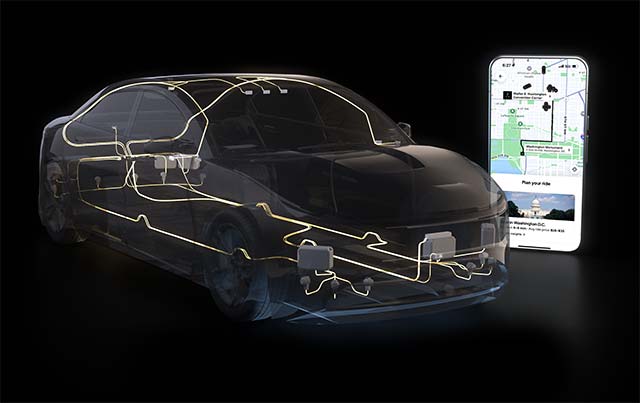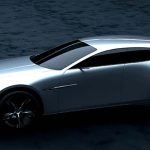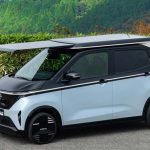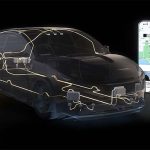
NVIDIA announced it is partnering with Uber to scale the world’s largest level 4-ready mobility network, using the company’s next-generation robotaxi and autonomous delivery fleets, the new NVIDIA DRIVE AGX Hyperion™ 10 autonomous vehicle (AV) development platform and NVIDIA DRIVE™ AV software purpose-built for L4 autonomy.
By enabling faster growth across the level 4 ecosystem, NVIDIA can support Uber in scaling its global autonomous drive fleet to 100,000 vehicles over time, starting in 2027. These vehicles will be developed in collaboration with NVIDIA and other Uber ecosystem partners, using NVIDIA DRIVE. NVIDIA and Uber are also working together to develop a data factory accelerated by the NVIDIA Cosmos™ world foundation model development platform to curate and process data needed for autonomous vehicle development.
NVIDIA DRIVE AGX Hyperion 10 is a reference production computer and sensor set architecture that makes any vehicle L4-ready. It enables automakers to build cars, trucks and vans equipped with validated hardware and sensors that can host any compatible autonomous-driving software, providing a unified foundation for safe, scalable and AI-defined mobility.
Uber is bringing together human drivers and autonomous vehicles into a single operating network — a unified ride-hailing service including both human and robot drivers. This network, powered by NVIDIA DRIVE AGX Hyperion-ready vehicles and the surrounding AI ecosystem, enables Uber to seamlessly bridge today’s human-driven mobility with the autonomous fleets of tomorrow.
“Robotaxis mark the beginning of a global transformation in mobility — making transportation safer, cleaner and more efficient,” said Jensen Huang, founder and CEO of NVIDIA. “Together with Uber, we’re creating a framework for the entire industry to deploy autonomous fleets at scale, powered by NVIDIA AI infrastructure. What was once science fiction is fast becoming an everyday reality.”
“NVIDIA is the backbone of the AI era, and is now fully harnessing that innovation to unleash L4 autonomy at enormous scale, while making it easier for NVIDIA-empowered AVs to be deployed on Uber,” said Dara Khosrowshahi, CEO of Uber. “Autonomous mobility will transform our cities for the better, and we’re thrilled to partner with NVIDIA to help make that vision a reality.”
NVIDIA DRIVE Level 4 Ecosystem Grows
Leading global automakers, robotaxi companies and tier 1 suppliers are already working with NVIDIA and Uber to launch level 4 fleets with NVIDIA AI behind the wheel.
Stellantis is developing AV-Ready Platforms, specifically optimized to support level 4 capabilities and meet robotaxi requirements. These platforms will integrate NVIDIA’s full-stack AI technology, further expanding connectivity with Uber’s global mobility ecosystem. Stellantis is also collaborating with Foxconn on hardware and systems integration.
Lucid is advancing level 4 autonomous capabilities for its next-generation passenger vehicles, also using full-stack NVIDIA AV software on the DRIVE Hyperion platform for its upcoming U.S. models.
Mercedes-Benz is testing future collaboration with industry-leading partners powered by its proprietary operation system MB.OS and DRIVE AGX Hyperion. Building on its legacy of innovation, the new S-Class offers an exceptional chauffeured level 4 experience combining luxury, safety and cutting-edge autonomy.
NVIDIA and Uber will continue to support and accelerate shared partners across the worldwide level 4 ecosystem developing their software stacks on the NVIDIA DRIVE level 4 platform, including Avride, May Mobility, Momenta, Nuro, Pony.ai, Wayve and WeRide.
In trucking, Aurora, Volvo Autonomous Solutions and Waabi are developing level 4 autonomous trucks powered by the NVIDIA DRIVE platform. Their next-generation systems, built on NVIDIA DRIVE AGX Thor, will accelerate Volvo’s upcoming L4 fleet, extending the reach of end-to-end NVIDIA AI infrastructure from passenger mobility to long-haul freight.
NVIDIA DRIVE AGX Hyperion 10: The Common Platform for L4-Ready Vehicles
The NVIDIA DRIVE AGX Hyperion 10 production platform features the NVIDIA DRIVE AGX Thor system-on-a-chip; the safety-certified NVIDIA DriveOS™ operating system; a fully qualified multimodal sensor suite including 14 high-definition cameras; nine radars, one lidar and 12 ultrasonics; and a qualified board design.
DRIVE AGX Hyperion 10 is modular and customizable, allowing manufacturers and AV developers to tailor it to their unique requirements. By offering a prequalified sensor suite architecture, the platform also accelerates development, lowers costs and gives customers a running start with access to NVIDIA’s rigorous development expertise and investments in automotive engineering and safety.
At the core of DRIVE AGX Hyperion 10 are two performance-packed DRIVE AGX Thor in-vehicle platforms based on NVIDIA Blackwell architecture. Each delivering more than 2,000 FP4 teraflops (1,000 TOPS of INT8) of real-time compute, DRIVE AGX Thor fuses diverse, 360-degree sensor inputs and is optimized for transformer, vision language action (VLA) models and generative AI workloads — enabling safe, level 4 autonomous driving backed by industry-leading safety certifications and cybersecurity standards.
In addition, DRIVE AGX’s scalability and compatibility with existing AV software lets companies seamlessly integrate and deploy future upgrades from the platform across robotaxi and autonomous mobility fleets via over-the-air updates.
Generative AI and Foundation Models Transform Autonomy
NVIDIA’s autonomous driving approach taps into foundation AI models, large language models and generative AI, trained on trillions of real and synthetic driving miles. These advanced models allow self-driving systems to solve highly complex urban driving situations with humanlike reasoning and adaptability.
New reasoning VLA models combine visual understanding, natural language reasoning and action generation to enable human-level understanding in AVs. By running reasoning VLA models in the vehicle, the AV can interpret nuanced and unpredictable real-world conditions — such as sudden changes in traffic flow, unstructured intersections and unpredictable human behavior — in real time. AV toolchain leader Foretellix is collaborating with NVIDIA to integrate its Foretify Physical AI toolchain with NVIDIA DRIVE for testing and validating these models.
To enable the industry to develop and evaluate these large models for autonomous driving, NVIDIA is also releasing the world’s largest multimodal AV dataset. Comprising 1,700 hours of real-world camera, radar and lidar data across 25 countries, the dataset is designed to bolster development, post-training and validation of foundation models for autonomous driving.
NVIDIA Halos Sets New Standards in Vehicle Safety and Certification
The NVIDIA Halos system delivers state-of-the-art safety guardrails from cloud to car, establishing a holistic framework to enable safe, scalable autonomous mobility.
The NVIDIA Halos AI Systems Inspection Lab, dedicated to AI safety and cybersecurity across automotive and robotics, performs independent evaluations and oversees the new Halos Certified Program, helping ensure products and systems meet rigorous criteria for trusted physical AI deployments.
Companies such as AUMOVIO, Bosch, Nuro and Wayve are among the inaugural members of the NVIDIA Halos AI System Inspection Lab — the industry’s first to be accredited by the ANSI Accreditation Board. The lab aims to accelerate the safe, large-scale deployment of Level 4 automated driving and other AI-powered systems.





